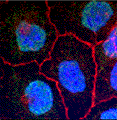Biochemistry, Department of
Document Type
Article
Date of this Version
1990
Citation
Journal of Bacteriology, Nov. 1990, p. 6459-6468 Vol. 172, No. 11
Abstract
In Escherichia coli at least five enzyme activities required for the beta-oxidation of fatty acids are associated with a multienzyme complex composed of two subunits in α2β2 conformation (A. Pramanik et al., J. Bacteriol. 137:469-473, 1979). In the present work, the DNA sequence of the genes encoding these two subunits, fadB and fadA, has been determined. The direction of transcription was from fadB to fadA rather than from fadA to fadB, as suggested previously (S. K. Spratt et al., J. Bacteriol. 158:535-542, 1984). Only 10 nucleotides separated the coding sequences for the two peptides, confirming the suggestion that these genes form an operon. The peptides encoded by fadB and fadA were 729 amino acids and 387 amino acids, respectively, in length. The larger and smaller peptides had predicted molecular masses of 79,678 and 40,876 Da, respectively. Recently, the sequence of thefadA gene was published in a separate report (Yang et al., J. Biol. Chem. 265:10424-10429, 1990). In this work, most of the DNA sequence for fad4 was confirmed, and 10 errors were corrected. Three of these nucleotide changes resulted in five amino acid residue changes predicted in the carboxy terminus of the fadA-encoded peptide. By comparison to other peptide sequences, the a subunit encoded withinfadB had 31% perfect identity with the rat peroxisomal enoyl-coenzyme A:hydratase-3-hydroxyacyl-coenzyme A dehydrogenase trifunctional enzyme over the entire length of the two peptides. In agreement with the work of Yang et al.,
the β subunit encoded within fadA had 35 to 45% perfect identity with five thiolase genes from different
eucaryotic sources over the entire length of the peptide.
Included in
Biochemistry Commons, Biotechnology Commons, Other Biochemistry, Biophysics, and Structural Biology Commons



Comments
Copyright © 1990, American Society for Microbiology